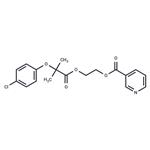Outline
Etofibrate ,under the trade name Lipo-Merz, is a broad-spectrum efficient lipid regulating drug . Etofibrate is a compound formed by clofibrate and nicotinic acid , after administration,in the body,it is decomposed into clofibrate and niacin,and plays its role quickly, and the effect is long, which is characterized by inhibiting the synthesis of cholesterol and triglycerides, increasing excretion of sterols fecal ,it is clinically mainly used for lowering plasma triglycerides. It is used for the treatment of hyperlipidemia (severe primary and secondary hyperlipidemia), arterial pulse atherosclerosis, cerebral vascular disorder and the end vascular disorder,vascular and retinal vascular disease, it is used for the prevention of stroke, heart attack, myocardial infarction, high blood pressure, high cholesterol and obesity, blood circulation disorders.Etofibrate is developed by the German Merz company,it belongs to phenoxy acetic acids and nicotinic acid lipid regulation drugs, it is used for hyperlipidemia ,it is listed in Germany, France, Italy, but currently it is not yet listed in China.
The above information is edited by the chemicalbook of Tian Ye.
Description
Etofibrate is a combination of niacin and clofibrate that acts as a hypolipidemic agent.
In vivo, etofibrate decreases plasma cholesterol and triglyceride concentrations and increases bile cholesterol content in rats. It also decreases thromboxane formation, platelet aggregation, and plasma viscosity and inhibits neointima formation in a carotid artery balloon injury rat model. Formulations containing etofibrate have been used to treat hyperlipidemia.
Chemical Properties
White to Off-White Solid
Originator
Lipo-Merz,Merz,W. Germany,1974
Uses
Antilipemic; reducing lipid levels in the blood.
Definition
ChEBI: Etofibrate is a monocarboxylic acid.
Manufacturing Process
A stream of ethylene oxide is passed through a solution of 107 g of 2-(pchlorophenoxy)-
2-methylpropionic acid and 2 g of zinc chloride in 200 ml of
toluene, previously heated to between 55°C and 60°C, until 24 g of the gas
have been dissolved. The reaction is allowed to continue for five hours, with
gentle stirring. After this time has elapsed, the solution is cooled and washed
successively with water, dilute ammonia and water until its pH becomes
neutral. It is dried over anhydrous sodium sulfate, the solvent is separated off
under vacuum, and the resulting liquid is the monoglycol ester of 2-(pchlorophenoxy)-
2-methylpropionic acid.
The product thus prepared is sufficiently pure to be used in the subsequent
reaction. In this way, 107 g of the ester are prepared, which represents a
yield of 83%.
To a solution of 93.8 g of the monoglycol ester in 500 ml of benzene, there
are added 55 g of nicotinic acid chloride and 25 g of trimethylamine dissolved
in 200 ml of benzene. The solution is stirred gently at a temperature of 60°C
for two hours. After this time, the solution is cooled and washed successively
with water, dilute hydrochloric acid, dilute ammonia and water until neutrality,
it is dried over anhydrous sodium sulfate, and the solvent is evaporated under
vacuum: in this way 110 g of glycol 2-(p-chlorophenoxy)-2-methylpropionate
nicotinate is prepared, which represents a yield of 84%. The product is a
slighly yellow oil having a refraction index of nD
20 =1.5422 and which is
distilled with decomposition at 214°C at a pressure of 0.3 mm.
Therapeutic Function
Antihyperlipidemic



